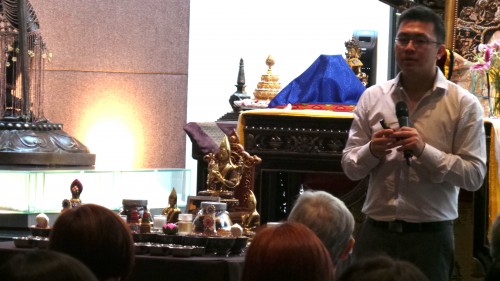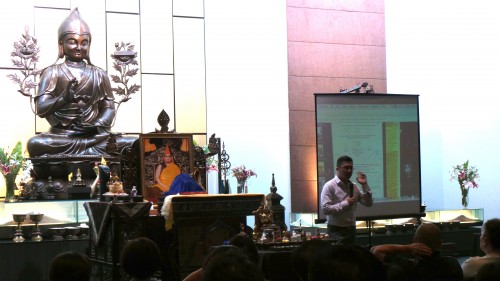
Recently, I was requested by H. E. Tsem Tulku Rinpoche to share my experience and knowledge of engaging in a Je Tsongkhapa retreat to people who would be interested to engage in it. This is fantastic despite the fact that the last time I performed a Tsongkhapa retreat was many years back. At that time, I was very green about all things Buddhist and the thought of going into retreat was pretty exciting and frightening at the same time.
However, I went through it and although it was only a 10,000 Migtsema retreat, it took a month because I was working on the outside and did my retreat right after. I cut down on my entertainment, clubbing, hangouts with friends and shopping. It was rather difficult for me at that time but very rewarding. Later, I did perform other retreats but this experience made it easier.
The actual talk was recorded and uploaded onto YouTube, which is available below. I have also accompanied some interesting pictures from the talk, which was held in Kechara House along with the actual slides that was presented during the talk. These basically form the main body of presentation during my talk. Enjoy and I hope my little presentation would inspire you to engage in a retreat yourself.
What is a Retreat?
- Retreat is a period or place of seclusion for the purposes of prayer and meditation.
- But, what are we retreating from?
- Worldly life of pleasures, attachments and self-gratification.
- What’s that? TV time, kids, meat, clubbing, sports, Internet, movies, friends, parties, shopping, beer, boyfriends, girlfriends and the things boyfriends and girlfriends, husbands and wives do, so on and so on…
- Ultimately, we are retreating from the ‘me, me me…’
- Why do we need to do that?
- It has not brought any sense of fulfillment or lasting happiness. If it did, the more we have, the happier we should be. Think about it.

What are we retreating to?
- From ‘me, me, me’, we retreat into the sacred practice of Je Tsongkhapa. In Tantra, it is called relating ourselves to the Yidam/Buddha.
- Retreats traditionally involves all of our body, speech and mind.
- Retreats in the past are mostly closed retreats but due to time and circumstances, open retreats are more popular these days.
- Retreats accumulates a lot of merits and purify a lot negative karma.
- You will feel tremendous peace, develop tremendous understanding of the Dharma and spiritual transformation.
- You will also encounter difficulties, obstacles and its basically spiritual detox. Hence, it is important that Setrap is propitiated during retreat.

Benefits of Je Tsongkhapa’s Practice
• We can pacify all our negative karma and obstacles in dependence on the 7-Limbed Practices in Guru Yoga:-
• Praise of Body, Speech & Mind
• Offerings
• Confession
• Rejoice
• Requesting teachings
• Asking our teachers to remain
• Dedication
• Can increase your life – there’s a meditation toward the end on the Lord of Death
• As he is mainly the embodiment of Manjushri, we will increase our wisdom quickly – which is important as it’s the antidote toward ignorance, the root of all sufferings. The best way to protect ourself from suffering is to increase wisdom.
• As we practice we purify negativities of the Body, therefore health will improve.
• We will make a connection with Maitreya Buddha (when Je Rinpoche passed away, he took rebirth as the Bodhisattva disciple of Maitreya called “Essence of Manjushri” of Jampal Nyingpo. From the Space of Maitreya’s truth body – clouds of his compassion for the beings of this world arise and as a result a rain of Dharma teachings descends upon beings through Je Tsongkhapa – as he descends from Maitreya’s heart.
• One will gain connection to be born as a disciple of the future Buddha Maitreya by this practice.
• Powa practice need not be practiced separately. One can take rebirth in Tushita or make a strong link to be born there eventually.
• On the basis of pacifying our negativity and obstacles and increasing our lifespan, merit, compassion, wisdom and spiritual power, if we rely upon this practice we shall gain all the realizations of Sutra and Tantra easily. Eventually attain the states of Union of no more learning or Buddhahood.

• If we follow the tradition of Je Tsongkhapa, we will be able to understand his commentaries on the Buddha’s teachings easily.
• A class of spirits such as Behar cannot harm us. Yamantaka or Shinje She means “opponent of outer, inner and secret obstacles”. This practice of Gaden Hlagyema and Migtsema are powerful methods for pacifying the three types of obstacles.
• Outer obstacles includes harm from human or non-humans, changes from the outer elements such as fire and water, different kinds of accidents, lacking necessary conditions for spiritual practice.
• Inner obstacles include sickness, strong delusions, and negative thoughts that arise within our mind.
• Secret obstacles are ordinary appearance, ordinary conceptions and subtle dualistic appearance.
• One will have harmony as Je Rinpoche is the Bodhisattva Vajrapani who pacifies the disharmonies from the outer and inner aspects of our lives if we rely upon him.
• Four separate practices of Riksum Gonpo and Maitreya will be accomplished at once.
• One will be able to make merit all day long and night in between the meditation sessions when in the practice. Je Rinpoche has dissolved into oneself.
• Purifies impurities – very important to break negative habits, change laziness, avoid diseases, anger & repercussions.
• Two parts – 7 wisdoms and * attaining realizations on the stages of the path.
*attaining realizations – recite Yonten Zhigyurma before dissolution & after migtsema. This will help us understand Dharma, Lamrim & realize it easier.
Altar setup based on the Tsongkhapa Retreat Instructions on Tsem Rinpoche’s blog
7 wisdoms:-
• Great Wisdom. Understand what to abandon easily
• Clear Wisdom – Understand subtle teachings such as emptiness.
• Quick Wisdom – Dispells doubts, wrong conceptions & unknowns in our minds. We understand the actual nature of these objects
• Profound wisdom – understand scriptures easily
• Wisdom of expounding the Dharma.
• Special Wisdom to understand the listeners aptitude
• Speak orderly
• Analogies/conclusive reasons
• Helps us to become good teachers
•Wisdom of Spiritual Debate to eradicate ignorance through skill of words
•Wisdom of Composing Dharma books – Understanding of subject matter, confidence to write books to reach many & bless them.
Actual Tsongkhapa Retreat instructions:-
For instructions on how to engage in Gaden Lhagyama/Guru Yoga:-
For other articles on Lama Tsongkhapa:-
For a complete explanation on Lama Tsongkhapa’s practice:-












I still remember this talk. This is the talk before I started my first Tsongkhapa Retreat.
Thank you Pastor David for sharing why, what and how to do retreats. It is very useful for a beginner to start my retreats. Even for my subsequent retreats, your videos are also being referenced, Thank you so much!